Abstract.
A new sulfate-reducing bacterium, strain 86FS1, was isolated from a deep-sea sediment in the western Mediterranean Sea with sodium lactate as electron and carbon source. Cells were ovoid, gram-negative and motile. Strain 86FS1 contained b- and c-type cytochromes. The organism was able to utilize propionate, pyruvate, lactate, succinate, fumarate, malate, alanine, primary alcohols (C2–C5), and mono- and disaccharides (glucose, fructose, galactose, ribose, sucrose, cellobiose, lactose) as electron donors for the reduction of sulfate, sulfite or thiosulfate. The major products of carbon metabolism were acetate and CO2, with exception of n-butanol and n-pentanol, which were oxidized only to the corresponding fatty acids. The growth yield with sulfate and glucose or lactate was 8.3 and 15 g dry mass, respectively, per mol sulfate. The temperature limits for growth were 10 °C and 30 °C with an optimum at 25 °C. Growth was observed at salinities ranging from 10 to 70 g NaCl l–1. Sulfide concentrations above 4 mmol l–1 inhibited growth. The fatty acid pattern of strain 86FS1 resembled that of Desulfobulbus propionicus with n-14:0, n-16:1ω7, n-16:1 ω5, n-17:1 ω6 and n-18:1 ω7 as dominant fatty acids. On the basis of its phylogenetic position and its phenotypic properties, strain 86FS1 affiliates with the genus Desulfobulbus and is described as a new species, Desulfobulbus mediterraneus sp. nov.
Similar content being viewed by others
Explore related subjects
Discover the latest articles and news from researchers in related subjects, suggested using machine learning.Author information
Authors and Affiliations
Additional information
Electronic Publication
Rights and permissions
About this article
Cite this article
Sass, A., Rütters, H., Cypionka, H. et al. Desulfobulbus mediterraneus sp. nov., a sulfate-reducing bacterium growing on mono- and disaccharides. Arch Microbiol 177, 468–474 (2002). https://doi.org/10.1007/s00203-002-0415-5
Received:
Revised:
Accepted:
Issue Date:
DOI: https://doi.org/10.1007/s00203-002-0415-5




